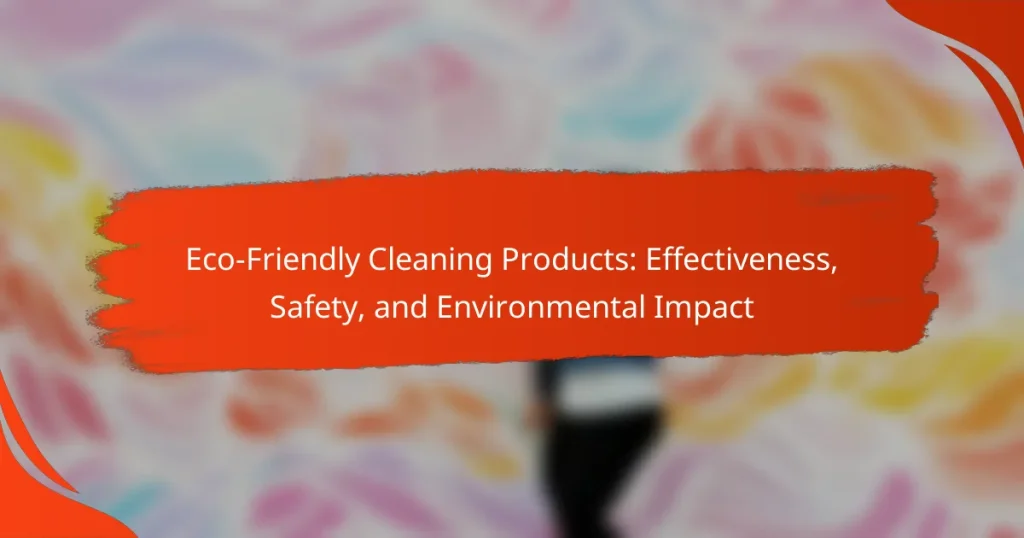Eco-friendly home products are designed to reduce environmental impact while ensuring functionality and durability. By choosing items like bamboo kitchenware, reusable silicone bags, and biodegradable cleaning supplies, you can contribute to a more sustainable lifestyle. These products not only help conserve resources but also promote a healthier planet for future generations.
Energy-Efficient Appliances: Savings, Performance, and Environmental Benefits
Plastic Waste Reduction: Strategies, Benefits, and Practical Tips
Eco-Friendly Cleaning Products: Effectiveness, Safety, and Environmental Impact
Eco-Friendly Home Decor: Style, Sustainability, and Material Choices
Biodegradable Alternatives: Household Items, Environmental Impact, and Safety
Sustainable Furniture Brands: Quality, Design, and Environmental Commitment
What are the best eco-friendly home products?
The best eco-friendly home products are those that minimize environmental impact while providing functionality and durability. Key options include bamboo kitchenware, reusable silicone bags, organic cotton bedding, biodegradable cleaning supplies, and LED light bulbs.
Bamboo kitchenware
Bamboo kitchenware is a sustainable alternative to plastic utensils and dishes. Bamboo grows quickly and requires minimal resources, making it an eco-friendly choice for cooking and serving. Look for products that are certified organic to ensure they are free from harmful chemicals.
When selecting bamboo items, consider their durability and maintenance. They should be hand-washed to extend their lifespan, as dishwashers can cause damage over time.
Reusable silicone bags
Reusable silicone bags are a versatile and eco-friendly option for food storage. Unlike single-use plastic bags, silicone bags can be used multiple times and are safe for both freezing and microwaving. They help reduce plastic waste significantly.
When choosing silicone bags, look for food-grade silicone that is BPA-free. They come in various sizes and can be used for snacks, meal prep, or even sous-vide cooking.
Organic cotton bedding
Organic cotton bedding is made from cotton grown without synthetic pesticides or fertilizers, making it safer for the environment and your health. This type of bedding is often softer and more breathable than conventional cotton, enhancing sleep quality.
When purchasing organic cotton sheets or pillowcases, check for certifications like GOTS (Global Organic Textile Standard) to ensure quality and sustainability. Expect to pay a premium, but the investment can lead to better comfort and longevity.
Biodegradable cleaning supplies
Biodegradable cleaning supplies break down naturally, reducing landfill waste and pollution. These products often use plant-based ingredients that are safer for both the environment and your home. Common options include all-purpose cleaners, laundry detergents, and dish soaps.
To ensure effectiveness, look for brands that provide clear ingredient lists and certifications. Avoid products with harsh chemicals that can harm aquatic life when washed down the drain.
LED light bulbs
LED light bulbs are energy-efficient alternatives to traditional incandescent bulbs, consuming significantly less electricity and lasting much longer. They can reduce energy bills and have a lower environmental impact due to their longevity.
When selecting LED bulbs, consider the brightness (measured in lumens) and color temperature (measured in Kelvins) to match your needs. While they may have a higher upfront cost, the savings on energy and replacement costs make them a smart choice over time.
How do eco-friendly products benefit the environment?
Eco-friendly products benefit the environment by reducing pollution, conserving resources, and promoting sustainability. These products are designed to minimize their ecological impact throughout their lifecycle, from production to disposal.
Reduce plastic waste
Eco-friendly products often use biodegradable or recyclable materials instead of traditional plastics, which can take hundreds of years to decompose. By choosing these alternatives, consumers can significantly decrease the amount of plastic waste that ends up in landfills and oceans.
For instance, opting for reusable bags, containers, and straws can cut down on single-use plastic consumption. Many cities and countries are implementing regulations to limit plastic use, making eco-friendly choices not just beneficial but increasingly necessary.
Lower carbon footprint
Using eco-friendly products can lead to a lower carbon footprint by reducing greenhouse gas emissions associated with production and transportation. Products made from sustainable materials often require less energy to manufacture, contributing to a smaller overall environmental impact.
For example, choosing locally sourced goods can minimize transportation emissions, while energy-efficient appliances consume less electricity. Consumers should look for certifications like Energy Star or similar labels that indicate lower energy consumption.
Conserve natural resources
Eco-friendly products are designed to use fewer natural resources, helping to preserve ecosystems and biodiversity. By selecting products made from renewable materials, consumers can help reduce the depletion of finite resources like fossil fuels and minerals.
For instance, bamboo and hemp are fast-growing plants that require less water and chemicals compared to traditional crops. Additionally, products that promote recycling and upcycling can extend the life of existing materials, further conserving resources.
Where to buy eco-friendly home products in the US?
In the US, eco-friendly home products can be found at various retailers that prioritize sustainability. Popular options include online marketplaces and major retail chains that offer dedicated sections for green products.
Amazon Eco-Friendly Store
Amazon features an Eco-Friendly Store that curates a wide range of sustainable home products. You can find items such as biodegradable cleaning supplies, energy-efficient appliances, and organic textiles. Look for products labeled with certifications like Energy Star or USDA Organic for assurance of their eco-friendliness.
Shopping on Amazon allows for easy price comparisons and customer reviews, helping you make informed choices. Additionally, Prime members may benefit from free shipping on eligible eco-friendly items.
Target’s Sustainable Products
Target offers a selection of sustainable products across various categories, including home goods, personal care, and cleaning supplies. Their commitment to sustainability is evident in their private label brands that focus on eco-friendly materials and practices.
When shopping at Target, check for their “Sustainable” label, which indicates products that meet specific environmental standards. You can also take advantage of their online shopping options for convenience.
Walmart Green Home Section
Walmart has a dedicated Green Home section that features eco-friendly products designed to reduce environmental impact. This includes items like reusable kitchenware, eco-conscious cleaning products, and energy-saving appliances.
Walmart’s pricing is often competitive, making it accessible for budget-conscious shoppers. Look for products with certifications such as Green Seal or the EPA’s Safer Choice label to ensure you are choosing truly sustainable options.
What criteria should you consider when choosing eco-friendly products?
When selecting eco-friendly products, consider their environmental impact, sustainability of materials, and certifications. These factors help ensure that your choices contribute positively to the planet and support responsible manufacturing practices.
Material sustainability
Material sustainability refers to the sourcing and composition of the products you choose. Look for items made from renewable resources, such as bamboo, recycled plastics, or organic cotton. These materials typically have a lower environmental footprint compared to conventional options.
Additionally, consider the durability of the materials. Products that last longer reduce the need for frequent replacements, ultimately minimizing waste. For example, a high-quality stainless steel water bottle is more sustainable than single-use plastic bottles.
Certifications and labels
Certifications and labels provide assurance that products meet specific environmental standards. Look for recognized certifications such as Energy Star, USDA Organic, or Fair Trade, which indicate adherence to eco-friendly practices. These labels can help you make informed choices.
Be cautious of greenwashing, where products are falsely marketed as eco-friendly. Research the meaning behind each label and ensure it aligns with your sustainability goals. A product with a credible certification is usually a safer choice.
Product lifecycle
The product lifecycle encompasses all stages from production to disposal. Consider how a product is made, how long it will last, and what happens at the end of its life. Products designed for easy recycling or composting are preferable as they reduce landfill waste.
Evaluate the overall impact of a product by asking questions about its manufacturing process, transportation emissions, and end-of-life options. For instance, a biodegradable cleaning product may be more beneficial than a conventional one that contributes to plastic pollution.
How do eco-friendly products compare in pricing?
Eco-friendly products often have higher upfront costs compared to conventional alternatives, but they can lead to long-term savings and environmental benefits. Understanding the pricing dynamics of these products can help consumers make informed choices.
Cost of bamboo vs. plastic
Bamboo products typically range from moderately priced to slightly more expensive than plastic options. For instance, bamboo utensils may cost around 10-20% more than their plastic counterparts, but they are biodegradable and more sustainable. When considering durability and environmental impact, bamboo often presents a better value over time.
Price range of organic cotton
Organic cotton products generally fall into a higher price bracket than conventional cotton, often costing 20-30% more. This premium reflects the sustainable farming practices used, which avoid harmful pesticides and fertilizers. Shoppers can expect to pay around $15-30 for organic cotton t-shirts, while standard cotton may be available for $10-20.
Long-term savings with LED bulbs
While LED bulbs have a higher initial cost, typically ranging from $5 to $15 each, they offer significant long-term savings. LED bulbs use about 75% less energy than traditional incandescent bulbs and can last up to 25,000 hours. Over time, this energy efficiency can lead to savings of tens of dollars on electricity bills, making them a cost-effective choice in the long run.
What are the top brands for eco-friendly home products?
Some of the leading brands for eco-friendly home products include Seventh Generation, Method, and Ecover. These companies focus on sustainability by using plant-based ingredients, recyclable packaging, and environmentally friendly manufacturing processes.
Seventh Generation
Seventh Generation is well-known for its commitment to sustainability, offering a wide range of household products, including laundry detergents, dish soaps, and paper goods. Their products are made from plant-based ingredients and are free from harmful chemicals, making them safe for both your family and the environment.
When choosing Seventh Generation products, look for their certifications, such as USDA Certified Biobased Product and EPA Safer Choice, which indicate adherence to strict environmental standards.
Method
Method is another popular brand that emphasizes stylish design alongside eco-friendliness. Their cleaning products are made from non-toxic, biodegradable ingredients and packaged in recycled materials. Method’s unique approach combines functionality with aesthetics, making their products appealing for modern homes.
Consider Method’s refillable options to reduce waste further. Their products are often available in bulk, which can save money and minimize packaging waste.
Ecover
Ecover focuses on creating effective cleaning solutions using renewable plant and mineral ingredients. Their products are designed to be biodegradable and come in environmentally friendly packaging. Ecover also emphasizes transparency, providing detailed information about their ingredients and sourcing practices.
For those looking to make a significant impact, Ecover offers a range of refill stations in various locations, allowing consumers to refill their containers and reduce plastic waste.






